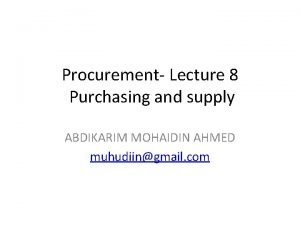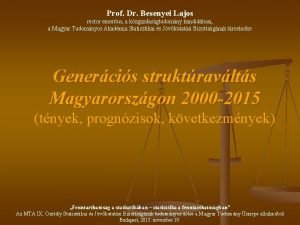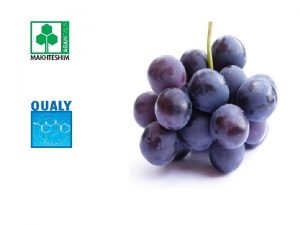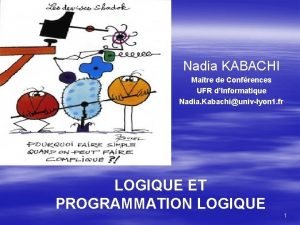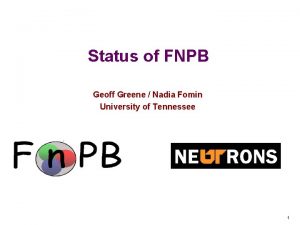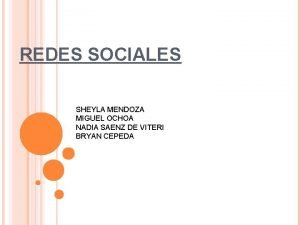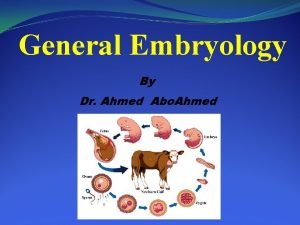Prof Dr Nadia Y Ahmed Emeritus Prof of

















- Slides: 17

Prof. . Dr. / Nadia Y. Ahmed Emeritus Prof. of Biochemistry, Fac. of Agric. Benha Univ. Dr/ Nesreen S. Salim

� Precipitation reactions occur when cations and anions in aqueous solution combine to form an insoluble ionic solid called a precipitate. Whether or not such a reaction occurs can be determined by using the solubility rules for common ionic solids. Because not all aqueous reactions form precipitates, one must consult the solubility rules before determining the state of the products and writing a net ionic equation. The ability to predict these reactions allows scientists to determine which ions are present in a solution, and allows industries to form chemicals by extracting components from these reactions.

� Precipitates are insoluble ionic solid products of a reaction, formed when certain cations and anions combine in an aqueous solution. The determining factors of the formation of a precipitate can vary. Some reactions depend on temperature, such as solutions used for buffers, whereas others are dependent only on solution concentration. The solids produced in precipitate reactions are crystalline solids, and can be suspended throughout the liquid or fall to the bottom of the solution

� Precipitation is the formation of a solid in a solution � solid formed is called the precipitate � A precipitation reaction occurs when water solutions of two different ionic compounds are mixed an insoluble solid separates out of solution. � Eg KCl + Ag. NO 3 → Ag. Cl + KNO 3 � The precipitate is itself ionic; the cation comes from one solution and the anion from another.

Solubility of a compound = concentrations of a soluble species at equilibrium with its insoluble form. � If the compound is sparingly soluble, it will produce cation & anion. � Eg Ag. Cl slightly dissolved in water. So Ag. Cl has a specific solubility, s = solid phase aq = aqueous phase � Ag. Cl (s) ↔ Ag+ (aq)+ Cl- (aq) � The equilibrium constant for the reaction is known as solubility product constant. � Ksp (Ag. Cl) = [Ag+][Cl-] � Concentration of any solid (Ag. Cl) is constant and is combined in the equilibrium constant to give Ksp �

� Solubility product constants are used to describe saturated solutions of ionic compounds of relatively low solubility. � A saturated solution is in a state of dynamic equilibrium between the dissolved, dissociated, ionic compound and the undissolved solid. � we have two reaction (or method ) to determine Precipitation Mohr method or � Volhard Method

� uses chromate ions as an indicator in the titration of chloride ions with a silver nitrate standard solution. After all the chloride has been precipitated as white silver chloride, the first excess of titrant results in the formation of a silver chromate precipitate, which signals the end point (1). The reactions are: � Ag + C l ↔ Ag. Cl(s) � 2 Ag + Cr. O 4 ↔ Ag 2 Cr. O 4(s)

� By knowing the stoichiometry and moles consumed at the end point, the amount of chloride in an unknown sample can be determined. This report describes experiments aimed at determining the concentration of chloride in a solid sample.

� The Volhard method of Ag+ determination is associated with argentometric titrations even though the titrating agent is actually SCN−: Volhard titration rxn � Ag+ + SCN− ↔ Ag. SCN(s) � analyte titrant

� The indicator in Volhard titrations is Fe 3+, which reacts with titrant to form a red colored complex: Volhard indicator rxn � Fe 3+ + SCN− ↔ Fe(SCN)2+(aq) � indicator titrant red complex

� This is a good method for the analysis of Ag+ in solution. We can extend the applicability of this method to anions such as I− through the procedure known as back-titration. A measured excess of Ag+ is added to the dissolved sample: � Ag+ + I− ↔ Ag. I(s) � excess reagent analyte

� After the precipitation of Ag. I is complete, the concentration of excess Ag+ titrant is determined by a Volhard titration. The number of moles of I− analyte originally present in the solution is easily calculated: � mol I− = mol Ag+ originally added to solution − mol Ag+ as determined by Volhard titration � In a similar manner, the Volhard titration method can be used to analyze for a number of anions.


� What is the ratio of silvers in coin if 2 g need 39. 6 ml of KCNS (0. 4103 g KCNS dissolved in 100 ml solute for silver precipitation. note that the coin is dissolved first then treated with KCNS in the presence of ferric ions.

� � � KCNS + Ag + → Ag. CNS- + Ag +→ Ag. CNS solution : E. N. of Ag = E. N. of KCNS 1 mol Ag+ = 1 equivalent � � 1 mol KCNS = 1 equivalent to calculate Normality of thiocyanate (KCNS) = (mass / molecular weight )/ volum = (0. 1403 /97. 17)/0. 100= 0. 0422 N � � � � E. N. of Ag = E. N. of KCNS = 0. 0422 × (39. 6 /1000) = 0. 0167 E. N. of Ag = mass (or weight) / molecular weight 0. 0167 = mass (or weight) / 108 So : mass = 108 × 0. 0167 = 1. 8039 g. % of Ag = (pure mass÷ total mass ) × 100 = (1. 8039 ÷ 2) × 100 = 90. 2 %

� Solution of acidic potassium oxalate its normality as acid equal 0. 2 N what is its normality when used to precipitate oxalate , what is the weight of Ca 2 C 2 O 4 (calcium oxalate) precipitate when one milliliter of solution with Ca. Cl 2. � Solution : � 1 mol KHC 2 O 4 = 1 equivalent (as acid) � 1 mol KHC 2 O 4 = 2 equivalent (as precipitate) � E. N. of Ca. C 2 O 4 = E. N. of KHC 2 O 4 � E. N. of Ca. C 2 O 4 = 0. 2 × (1/1000) = 0. 0002 E. � Weight of Ca. C 2 O 4 = 0. 0002 (128/2)= 0. 0128 g �

� What is the number of sodium chloride milliliters (normality equal 3 ). 3 N needed for preicipitating 500 ml of silver in silver nitrate solution. � Solution: � E. N. of Na. Cl = E. N. of Ag � Volum × normality = weight of silver/ E. W. � V × 3 = ((500/1000) /108) � V = 1. 5 ml �
 Ahmed muhudiin ahmed
Ahmed muhudiin ahmed Regents professor emeritus
Regents professor emeritus Asu emeritus college
Asu emeritus college Rector emeritus
Rector emeritus Professor emeritus keith l. moore
Professor emeritus keith l. moore Nadia preghenella
Nadia preghenella Kabachi nadia
Kabachi nadia Nadia persaud coroner
Nadia persaud coroner Buffalo schools reopening
Buffalo schools reopening Dr pile nadia
Dr pile nadia Nadja bilek
Nadja bilek Moulay driss aqil
Moulay driss aqil Nadia casanova
Nadia casanova Danielle villeneuve
Danielle villeneuve Nadia.owen
Nadia.owen Florence cyrulnik jeune
Florence cyrulnik jeune Nadia wemboluan redes sociales
Nadia wemboluan redes sociales Nadia montasser
Nadia montasser
